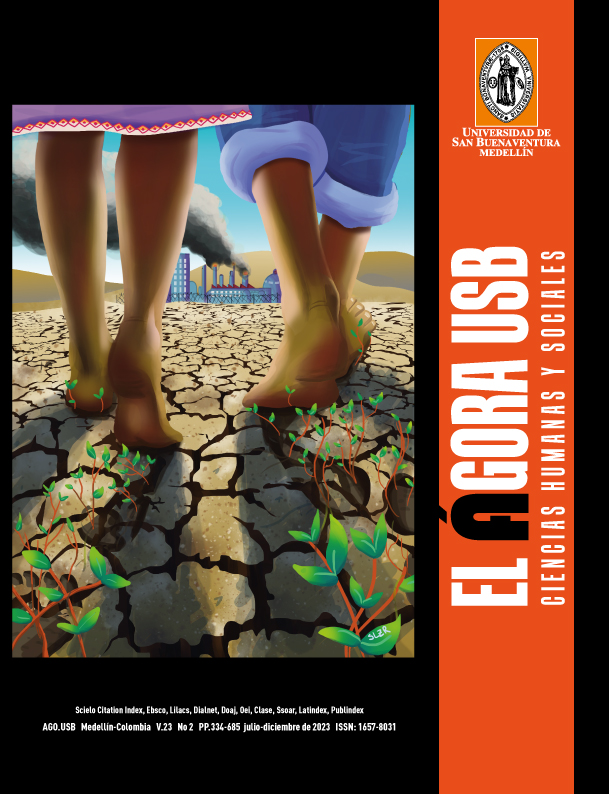The authors are also adhere to the creative commons license 4.0 (https://creativecommons.org/licenses/by-nc-nd/4.0/deed.es)
Attribution - NonCommercial - SinDerivar 4.0 International (CC BY - NC - ND 4.0)
Abstract
The purpose of this article is to share the discussion on the fundamental role of the constitutive elements of the voice in the diagnostic processes and therapeutic proposals related to ASD. Elements found in the study “Development of clinical protocol for early diagnosis of autism” ((Villalobos & Pacca, 2021). The cases, Vera & Saul, are taken up again to illustrate the place of voice and speech in intersubjective development. From these cases, the scope and limitations of some tests for the diagnosis of ASD when evaluating communicative indicators become evident. Given that voice and speech bear the imprint of each person’s subjectivity, considering their analysis becomes relevant in the comprehensive diagnosis of ASD, as it complements the diagnostic observation proposed by the main tests worldwide recognized for this developmental problem, such as –ADOS-2– Autism Diagnostic Observation Scale-2
Keywords:
References
Asociación Americana de Psiquiatría. Guía de consulta de los criterios diagnósticos del DSM 5. (2013). Arlington, VA. https://www.eafit.edu.co/ninos/reddelaspreguntas/Documents/dsm-v-guia-consulta-manual-diagnostico-estadistico-trastornos-mentales.pdf
Baker, K. F.; Montgomery, A. A. & Abramson, R. Brief. (2010). Report: Perception and Lateralization of Spoken Emotion by Youths With High-Functioning Forms of Autism. J Autism Dev Disord 40, 123-129. https://doi.org/10.1007/s10803-009-0841-1
Belin, P.; Fecteau, S.; Bédard, C.(2004). Thinking the voice: neural correlates of voice perception. Trends CognSci. Mar;8(3):129-35. https://doi.org/10.1016/j.tics.2004.01.008
Brennand, R.; Schepman, S. & Rodway, R. (2011). Vocal emotion perception in pseudo-sentences by secondary-schoolchildrenwithAutism Spectrum Disorder. Research in Autism Spectrum Disorders. Volume 5, Issue 4,2011, Pages 1567-1573, ISSN 1750-9467, https://doi.org/10.1016/j.rasd.2011.03.002
Boysson-Bardies, B. (2003) Le langage, ¿Qu’ est-ce que c’est?. Odile Jacob, Paris.
Brentani, H.; Paula, C. S.; Bordini, D.; Rolim, D.; Sato, F.; Portolese, J.; Pacifico, M. C.; & Mc-Cracken, J. T. (2013). Autismspectrumdisorders: an overview ondiagnosis and treatment. Revista brasileira de psiquiatria (Sao Paulo, Brazil : 1999), 35 Suppl 1, S62-S72. https://doi.org/10.1590/1516-4446-2013-S104
Catão, I. (2009). O bebê nasce pela boca: voz, sujeito e clínica do autismo. Instituto Langage.
Cirelli, L. K.; Trehub, S. E. & Trainor, L. J. (2018). Rhythm and melody as social signals for infants. Annals of the New York Academy of Sciences, 10.1111/nyas.13580. Advance online publication. https://doi.org/10.1111/nyas.13580
Danón, L. (2007) Conceptos y errores animales Conocimiento, normatividad y acción. Córdoba; p.545 - 556
Español, S. (2008). La entrada al mundo a través de las artes temporales. Estudios de psicología,29 (1) 81-102. https://www.aacademica.org/silvia.espanol/108.pdf ?view
Español, S. (2010). Performances en la infancia: cuando el habla parece música, danza y poesía. Epistemuss, 1 (1), 59-95. https://www.aacademica.org/silvia.espanol/27.pdf
Español, S. (2012). El desarrollo semiótico. En: M. Carretero y J. A. Castorina (Eds.) Desarrollo Cognitivo y Educación. Los inicios del conocimiento, Vol. I. pp.219-240. Paidós.
Lord, C.; Rutter, M.; DiLavore, P. C.; Risi, S.; Gotham, K.; Bishop, S. L.; Luyster, R. J. & Guthrie, W., (S. F.). TEA. ADOS-2 Escala de Observación para el Diagnóstico del Autismo -2©. TEA Ediciones. http://web.teaediciones.com/ADOS-2-Escala-de-Observacion-para-el-Diagnostico-del-Autismo---2.aspx
Maleval, J. (2018). El autista y su voz. Gredos.
Martínez, M. & Shifres, F. (2010). El trabajo interdisciplinario en psicología: Análisis del canto de un niño con Trastorno Autista en el marco del Juego Musical. https://www.aacademica.org/favio.shifres/51
Martínez, M. & Shifres, F. (2010). Vestigios musicales de la intersubjetividad primaria en trastornos del espectro autista. UBA - APADEA. Universidad Nacional de la Plata. Sociedad Argentina para las ciencias cognitivas de la música. https://www.aacademica.org/
favio.shifres/155.pdf
Muratori, F. (2008). El autismo como efecto de un trastorno de la intersubjetividad primaria (I). Revista de Psicopatología y Salud Mental Del Niño y Del Adolescente. 12. 39-49. https://www.researchgate.net/publication/286388147_El_autismo_como_efecto_de_
un_trastorno_de_la_intersubjetividad_primaria_I
Muratori, F. (2009). El autismo como efecto de un trastorno de la intersubjetividad primaria (y II). Psicopatol. salud mental. 13, pág. 21-30. https://es.scribd.com/doc/86602014/Autismo-como-Efecto-de-un-Trastorno-de-la-Intersubjetividad-Primaria-II
Nadel, J. (2014). Réhabiliter scientifiquement l’imitation au bénéfice de l’autisme. https://www.cairn.info/revue-l-information-psychiatrique-2014-10-page-835.htm
Pacca, L. (2020). Necesidades especiales, educación inclusiva y COVID-19 [Webinar]. Facultad de Psicología de la Universidad Del Valle. https://youtu.be/eOO2H02dPncPEPS-C (S. F.) PEPS-C. http://www.peps-c.com/
Real Academia Española (2021): Diccionario de la lengua española, 23° ed. [Versión 23.3 en línea] https://dle.rae.es/palabra
Rivière, A. (1997). Desarrollo normal y Autismo (1/2). Universidad Autónoma de Madrid) Curso de Desarrollo Normal y Autismo. http://www.autismoandalucia.org/wp-content/ uploads/2018/02/Riviere-_Desarrollo_normal_y_Autismo.pdf
Rivière, A. & J. Martos (coord.). (2000). El niño pequeño con autismo. Asociación de padres de niños autistas.
Schelinski, S.; Borowiak, K.; vonKriegstein, K. (2016). Temporal voice areas exist in autismspectrumdisorder but are dysfunctional for voiceidentity recognition. Social Cognitive and Affective Neuroscience, Volumen 11, Issue 11, 1812- 1822, https://doi.org/10.1093/
scan/nsw089
Sellin, B. (2017). Quiero dejar de ser un dentrodemi. Ed. Galaxia Gutenberg. España
Stern, D. N (1991/2005) El Mundo Interpersonal del Infante. Buenos Aires, Paidós.
Stern, D. (2005). Le désir d’intersubjectivité. Pourquoi ? Comment ? Cahiers critiques de thérapie familiale et de pratiques de réseaux, 2(2), 29-42. https://doi.org/10.3917/ctf.035.0029
Trevarthen, C. & Aitken, K. J. (2001). Infant intersubjectivity: Research, theory, and clinical applications. Journal of Child Psychology and Psychiatry, 42(1), 3-48. https://doi. org/10.1111/1469-7610.00701
Trevarthen, C. & Daniel, S. (2005). Disorganizedrhythm and synchrony: earlysigns of autism and Rett syndrome. Brain &development, 27 Suppl 1, S25-S34. https://doi.org/10.1016/j.braindev.2005.03.016
Tustin, F. (1990). El cascarón protector en niños y adultos. Amorrortu editores Buenos Aires
Villalobos, M. E. (2003). Resiliencia y autismo conferencia ofrecida en el coloquio Internacional Factores implicados en el procesos de ruptura de la resiliencia, medios traumatizantes y procesos de resiliencia. Coloquio Internacional
Villalobos, M. E. (2006). Interacciones Tempranas: Investimento de sí. Psicología desde el Caribe, 17.60 - 85. https://www.redalyc.org/pdf/213/21301703.pdf
Villalobos, M. E. (2014). Construcción psicológica y desarrollo temprano del sujeto: una Perspectiva clínico-psicológica de su ontogénesis. Programa Editorial Universidad del Valle.
Villalobos, M. E., Pacca, L. (2020) Informe final Investigación “Desarrollo de protocolo clínico para el diagnóstico temprano del autismo”. Universidad Del Valle
Williams, D. (2012). Nadie en ningún lugar. La historia extraordinaria de una autista desde su infancia hasta su juventud. Ned ediciones.




















